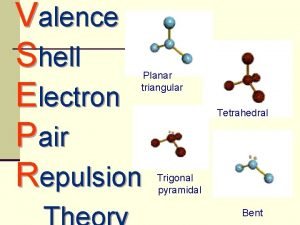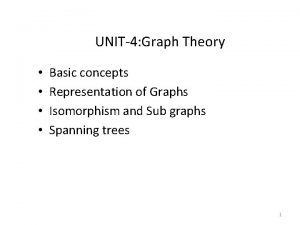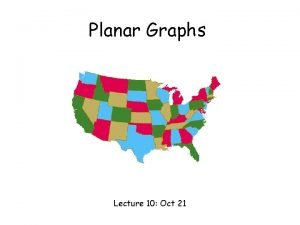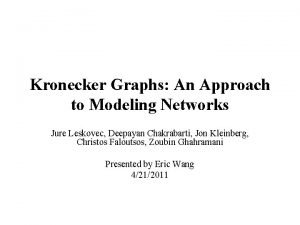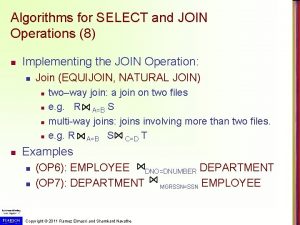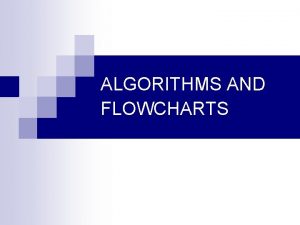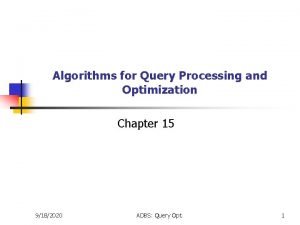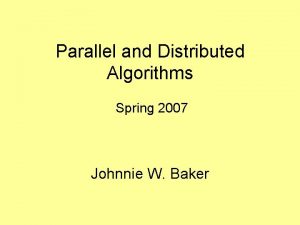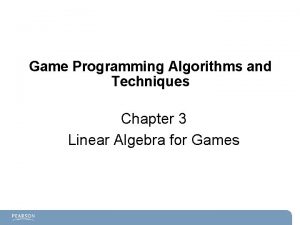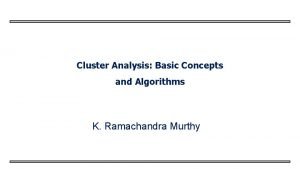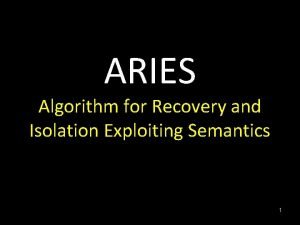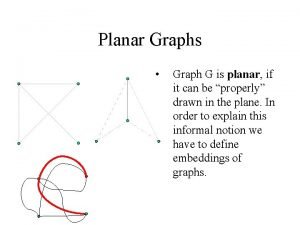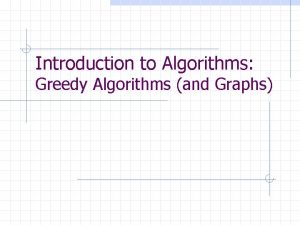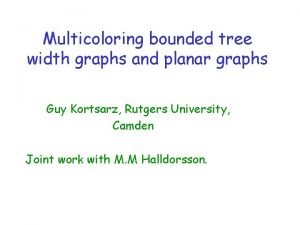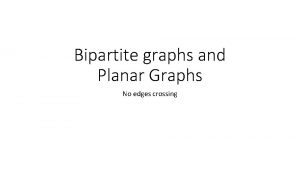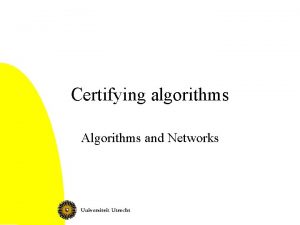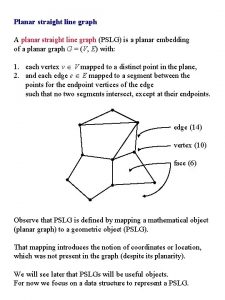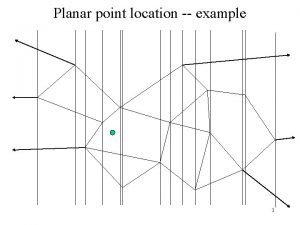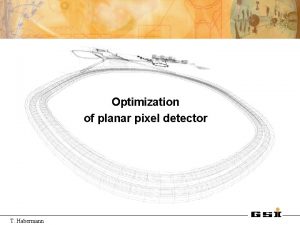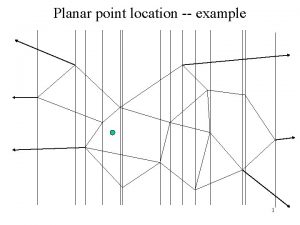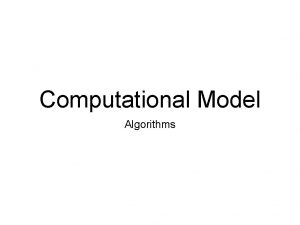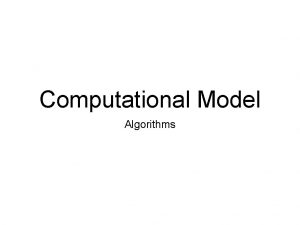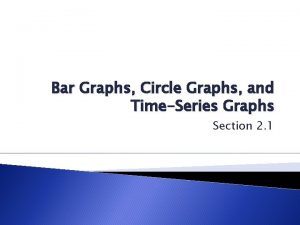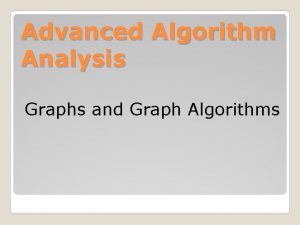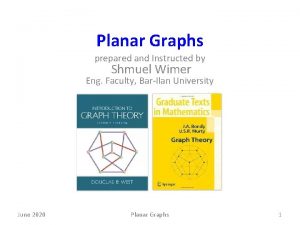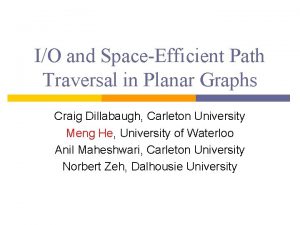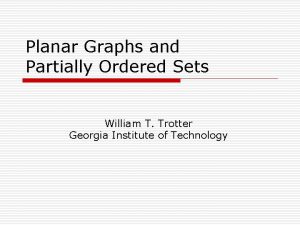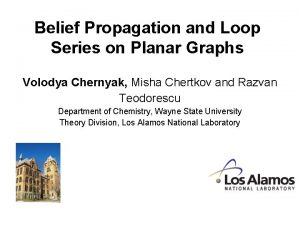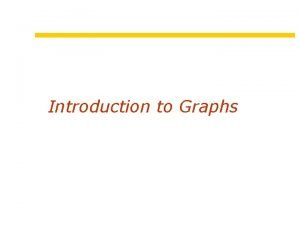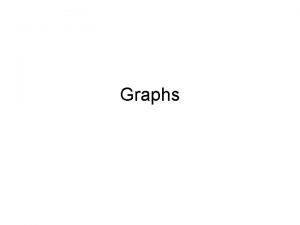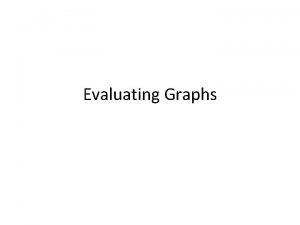Planar graphs Algorithms and Networks Planar graphs Can


































- Slides: 34

Planar graphs Algorithms and Networks

Planar graphs • Can be drawn on the plane without crossings • Plane graph: planar graph, given together with an embedding in the plane • Many applications… • Questions: – Testing if a graph is planar – Finding a nice or good drawing of a planar graph • But what does that mean? – Solving problems for planar graphs 2 Planar graphs

Graph drawing / network layout • Applications: – Visually representing a network (e. g. , social network, organization structure, data bases (ERdiagrams), software (e. g. , UML-diagrams), flow charts, phylogenetic trees (biology, evolution), … – Design of “chip” layout (VLSI) –… 3 Planar graphs

Some notions • • 4 Faces Exterior face Interior faces Each edge is incident to 2 faces, except in special cases: Planar graphs

The smallest graphs that are not planar • K 5, K 3, 3 5 Planar graphs

Kuratowski / Wagner • Theorem (Kuratowski, Wagner, 193*) A graph is planar, if and only if it does not contain the K 5 and the K 3, 3 as a homeomorphic subgraph / as a minor. • H is a minor of G, if H can be obtained from G by a series of 0 or more deletions of vertices, deletions of edges, and contraction of edges. • Does not yield fast recognition algorithm! 6 Planar graphs

The Petersen graph is not planar, as it has K 3, 3 as minor 7 Planar graphs

Euler’s theorem • Theorem (Euler) Let G be a connected plane graph with n vertices, m edges, and f faces. Then n + f – m = 2. • Proof. By induction. – True if m=0. – If G has a circuit, then delete an edge and … – If G has a vertex v of degree 1, then delete v and … • … 8 Planar graphs

Euler’s theorem Corollaries • If G is a connected plane graph with no parallel edges and no self-loops, with n > 1, then m £ 3 n-6. – Every face `has’ at least three edges; each edge `is on’ two faces, or twice on the same face. • Every plane graph with no parallel edges and no self-loops has a vertex of degree at most 5. • Has algorithmic consequences… 9 Planar graphs

Duality • The dual G* of a plane graph G – A vertex in G* for each face of G – An edge in G* when faces share an edge in G 10 Planar graphs

Drawings of planar graphs • Different types • Vertices are: – Points in 2 -dimensional space – Rectangles, other objects • Edges are – – 11 Usual model Straight lines Curves Lines with bends Adjacencies or intersections of objects Planar graphs

Drawing planar graphs In steps: 1. Test if G is planar, and 2. Find for each vertex, a clockwise ordering of its incident edges, such that these orderings allow a planar embedding, and then 3. Assign coordinates to vertices 12 Planar graphs

Planarity testing: reduction to biconnected graphs • First, suppose G is biconnected. – G is biconnected, if for each vertex v, G-v is connected. – A biconnected component of G is a maximal subgraph that is biconnected. – A graph is planar, if and only if each of its biconnected components is planar. • Each biconnected component can be drawn with any vertex on its exterior face. • Build drawing of G by putting drawings of biconnected components together. • Easier non-constructive argument: G has a K 5 or K 3, 3 minor, iff a biconnected component of G has such a minor. 13 Planar graphs

Cycles with pieces • Take a cycle C in G. • Divide edges not on C of G into classes: – e and e’ in the same class if there is a path starting with e, ending with e’, using no vertices on C as intermediate points – A class forms a piece. • Pieces are – A single edge between two vertices on C – A connected graph with at least one vertex not on C 14 Planar graphs

Separating cycles • A cycle is separating if it has at least two pieces. • Plan: – Find separating cycle C (how? ) – Test for each piece + C if it is planar (recursion) – Determine for each piece if it has to be drawn inside or outside C (matching problem; details follow). 15 Planar graphs

Finding a separating cycle • • • Find a cycle C. If C separating: done. Otherwise, let P be the unique piece. If P is a path: G is planar: done. Otherwise: – Take two consecutive attachments v, w of P in the circular ordering of C, and let Q be the part of C between the attachments without another attachment. – Take a path R between v and w in P avoiding other attachments – C – Q + R is a separating cycle 16 Planar graphs

The interlacement graph • Pieces can be `inside’ or `outside’ the cycle • Build interlacement graph – Each piece is a vertex in interlacement graph – Pieces are adjacent, when they cannot be at the same side (look to attachments) 17 Planar graphs

Theorem • Let C be a separating cycle in G. G is a planar graph, if and only if – For each piece P, C+P is planar. – The interlacement graph is bipartite. Gives a polynomial time algorithm! 18 Planar graphs

Interlacement graph can be built in O(n 2) time • For each piece – Partition C into intervals with respect to attachments – For each other piece • Look whether all attachments are in the same interval • If not, they conflict. 19 Planar graphs

Algorithm • • • Find a cycle C Test if C is separating. If not, use method to build separating cycle C’. Find pieces of C’. Build interlacement graph. Test if interlacement graph is bipartite. If not: G is not planar, stop. • Otherwise, test for each piece P, recursively, if P+C’ is planar. 20 Planar graphs

Time • O(n 3). • Can be done faster: O(n) algorithms exist. • Finding clockwise orderings of edges per vertex can also be done: several details… 21 Planar graphs

Force directed methods • Method for arbitrary graphs • Uses physical analogy: – Force system – Method to find equilibrium state • Advantages: – Relatively easy to understand implement – Often reasonably nice results 22 Planar graphs

Springs and electrical forces method • Edges are springs • Vertices repel each other • Force on vertex: – fuv is force on spring – guv is repelling force 23 Planar graphs

Spring force • Assume some `wanted length’ of an edge luv. (E. g. , 1. ) • Spring wants to assume length luv; force is proportional to difference with luv. • Choose some stiffness of the spring kuv. ’ • Force in x-direction is (y-direction similar): 24 Planar graphs

Repelling force • Vertices are repelling particles • Follow inverse square law • k’uv is strength of repulsion (choose some number, e. g. , experimentally) • Repelling force of v in x-direction: Similar in y-direction 25 Planar graphs

Search for equilibrium • Position where all vertices have a force of 0 towards them (sum of spring and repelling forces) • Springs have lengths of edges go to desired length • Repelling has vertices not too close together 26 Planar graphs

Searching for equilibrium • Numerical techniques • Simple algorithm: – Take for each vertex a random position – Repeat: • Compute for each vertex its force • Move all vertices to new position depending on their forces Until in sufficient rest • Faster algorithms exist 27 Planar graphs

Barycenter method • Tutte, 1960 • Differences with force method – No repelling forces – luv = 0 – Stiffness is 1 – Vertices at exterior face get fixed positions 28 Planar graphs

Force on a vertex Where pu is the position of u on the plane If v is a free vertex 29 Planar graphs

Finding equilibrium • System of forces can be written as set of linear equations • Fast converging algorithms • For planar graphs, system can be solved in O(n 1. 5) time 30 Planar graphs

Barycenter draw pseudocode • Place all fixed vertices at corners of polygon around origin, and all free vertices on origin • Repeat – For each free vertex v do • x(v) = 1/degree(v) * S((u, v) in E) x(u) • y(v) = 1/degree(v) * S((u, v) in E) y(u) until sufficient convergence 31 Planar graphs

Theorem of Tutte • If G is a triconnected planar graph, then this method yields a planar drawing of G. – Assuming … – In practice, layers become smaller in the inside • Generalizations with more complicated forces sometimes also have this property • If G is not triconnected, then we can make it triconnected by adding edges 32 Planar graphs

Grid drawings • Many results on planar drawings, e. g. , • Theorem (Schnyder, 1990) Every planar graph G has a plane drawing, such that – Each edge is a straight line – Vertices are mapped to pairs of integers in {0, 1, …, n – 2} * {0, 1, …, n – 2} 33 Planar graphs

Many other results • Embeddings with small areas and few bends per edge • Drawings where vertices are represented by rectangles with an edge if rectangles touch • … 34 Planar graphs
 Trigonal planar
Trigonal planar Computer networks routing algorithms
Computer networks routing algorithms Networks and graphs: circuits, paths, and graph structures
Networks and graphs: circuits, paths, and graph structures Comparison of virtual circuit and datagram network
Comparison of virtual circuit and datagram network Graph theory
Graph theory Connected planar graph
Connected planar graph Basestore iptv
Basestore iptv Testability tips in software testing
Testability tips in software testing Graphs that enlighten and graphs that deceive
Graphs that enlighten and graphs that deceive Kronecker graphs: an approach to modeling networks
Kronecker graphs: an approach to modeling networks Graphs that compare distance and time are called
Graphs that compare distance and time are called End behavior chart
End behavior chart Computational thinking algorithms and programming
Computational thinking algorithms and programming Design and analysis of algorithms syllabus
Design and analysis of algorithms syllabus Ajit diwan iit bombay
Ajit diwan iit bombay Association analysis: basic concepts and algorithms
Association analysis: basic concepts and algorithms Computer arithmetic: algorithms and hardware designs
Computer arithmetic: algorithms and hardware designs Cos 423 princeton
Cos 423 princeton Data structures and algorithms tutorial
Data structures and algorithms tutorial Algorithms for select and join operations
Algorithms for select and join operations Algorithms and flowcharts
Algorithms and flowcharts Undecidable problems and unreasonable time algorithms.
Undecidable problems and unreasonable time algorithms. Information retrieval data structures and algorithms
Information retrieval data structures and algorithms Data structures and algorithms bits pilani
Data structures and algorithms bits pilani Cluster analysis basic concepts and algorithms
Cluster analysis basic concepts and algorithms Probabilistic analysis and randomized algorithms
Probabilistic analysis and randomized algorithms Design and analysis of algorithms introduction
Design and analysis of algorithms introduction Algorithms for query processing and optimization
Algorithms for query processing and optimization Synchronization algorithms and concurrent programming
Synchronization algorithms and concurrent programming Parallel and distributed algorithms
Parallel and distributed algorithms Data structures and algorithms iit bombay
Data structures and algorithms iit bombay Lerp
Lerp Cluster analysis basic concepts and algorithms
Cluster analysis basic concepts and algorithms Cjih
Cjih Aries in dbms
Aries in dbms
